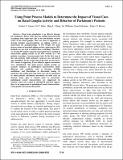| dc.contributor.author | Sarma, Sridevi V. | |
| dc.contributor.author | Eden, Uri T. | |
| dc.contributor.author | Cheng, Ming L. | |
| dc.contributor.author | Williams, Ziv | |
| dc.contributor.author | Eskandar, Emad | |
| dc.contributor.author | Brown, Emery N. | |
| dc.date.accessioned | 2010-12-17T16:17:06Z | |
| dc.date.available | 2010-12-17T16:17:06Z | |
| dc.date.issued | 2010-01 | |
| dc.date.submitted | 2009-12 | |
| dc.identifier.isbn | 978-1-4244-3871-6 | |
| dc.identifier.issn | 0191-2216 | |
| dc.identifier.other | INSPEC Accession Number: 11149289 | |
| dc.identifier.uri | http://hdl.handle.net/1721.1/60301 | |
| dc.description.abstract | Deep brain stimulation is an effective therapy for Parkinson's disease (PD) that has enabled microelectrode recordings from single-unit cells in the sub-thalamic nucleus (STN) of the basal ganglia. This rare data is important to develop detailed characterizations of spiking activity to understand the pathophysiology of PD. Despite the point process nature of neuronal spiking activity, point process (PP) methods are not used to analyze these recordings. Therefore, we develop PP models using the generalized linear method to characterize spiking activity in 28 STN neurons in 7 PD patients executing a two-step motor task. In the first step of the task, patients could anticipate visual go cues and moved once prompted. In the second step of the task, go cues had a 50% chance of appearing. If cues failed to appear, movements were self-initiated. The point process models provide an accurate summary of pathological characteristics under different cued conditions such as bursting, 10-30 Hz oscillations, and fluctuations in directional tuning. In particular, the models show that when cues can be anticipated or when patients self-initiate movements (in both cases an internal motor plan is formed prior to movement), pathological neural characteristics are suppressed. In contrast, when cues cannot be anticipated and later appear, there is no suppression of pathological neural characteristics. Consequently, movements deteriorate. | en_US |
| dc.language.iso | en_US | |
| dc.publisher | Institute of Electrical and Electronics Engineers | en_US |
| dc.relation.isversionof | http://dx.doi.org/10.1109/CDC.2009.5399938 | en_US |
| dc.rights | Article is made available in accordance with the publisher's policy and may be subject to US copyright law. Please refer to the publisher's site for terms of use. | en_US |
| dc.source | IEEE | en_US |
| dc.title | Using point process models to determine the impact of visual cues on basal ganglia activity and behavior of Parkinson's patients | en_US |
| dc.type | Article | en_US |
| dc.identifier.citation | Sarma, S.V. et al. “Using point process models to determine the impact of visual cues on basal ganglia activity and behavior of Parkinson's patients.” Decision and Control, 2009 held jointly with the 2009 28th Chinese Control Conference. CDC/CCC 2009. Proceedings of the 48th IEEE Conference on. 2009. 7716-7722. ©2010 IEEE. | en_US |
| dc.contributor.department | Massachusetts Institute of Technology. Department of Brain and Cognitive Sciences | en_US |
| dc.contributor.approver | Brown, Emery N. | |
| dc.contributor.mitauthor | Brown, Emery N. | |
| dc.contributor.mitauthor | Sarma, Sridevi V. | |
| dc.relation.journal | Proceedings of the 48th IEEE Conference on Decision and Control, 2009 held jointly with the 2009 28th Chinese Control Conference. CDC/CCC 2009 | en_US |
| dc.eprint.version | Final published version | en_US |
| dc.type.uri | http://purl.org/eprint/type/ConferencePaper | en_US |
| dspace.orderedauthors | Sarma, Sridevi V.; Eden, Uri T.; Cheng, Ming L.; Williams, Ziv; Eskandar, Emad; Brown, Emery N. | en |
| dc.identifier.orcid | https://orcid.org/0000-0003-2668-7819 | |
| mit.license | PUBLISHER_POLICY | en_US |
| mit.metadata.status | Complete | |
